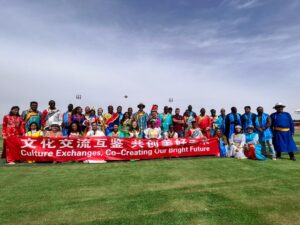…Culture exchanges, Co-creating a bright future
By Juliet ETEFE, Beijing, China ([email protected])
The China Seminar for Young Media Professionals from Developing Countries was indeed a highly insightful meeting that paved the way for culture exchanges, co-creating a bright future.
Organised by the China International Communications Group’s (CICG) Institute of International Studies and Advanced Training, the seminar brought together media professionals from different countries, creating a platform that allowed for experiences, knowledge, and expertise to be shared.

Through interactions with fellow media professionals from Ghana, Zimbabwe, Pakistan, Bahamas, Suriname, South Sudan, Palestine, Nigeria, Sri Lanka and Cameroon, the attendees had the chance to learn about different cultures, traditions, and perspectives. These cross-cultural exchanges fostered mutual understanding, respect, and appreciation, leading to potential collaborations and partnerships in the future.
The outlined activities and discussions, allowed participants to brainstorm innovative ideas and strategies to address common challenges faced by media professionals globally.
This knowledge exchange was invaluable as it provided them with insights that they could apply to their own media industries and at large development at home.

The main highlight of the seminar was the opportunity to learn about China’s media landscape and development. Through various sessions, participants gained a comprehensive understanding of China’s media industry and some key policies.
Another key highlight of the seminar was the visit to very interesting tourist or historic sites in Beijing and the Gansu province.

“For us from Ghana, the Seminar for Young Media Professionals from Developing Countries has broadened our scope on the journalism industry beyond our Country. It has also shaped our understanding of human resources and socio-economic development and more importantly, given us a better understanding of China.

As media practitioners, this is a great opportunity for us and we are grateful to experience the beautiful culture and history of China. Visits to the Great Wall, the Museums, the warmth reception at Dunhuang and Subei as well as other significant historical sites were eye openers,” Ms. Juliet Etefe of the Business and Financial Times (B&FT) stated in a closing remark on behalf of the Ghanaian participants (Herself, Ms. Rashida Ibrahim and Mr. Awudu Mahama).
Places visited

Though the seminar was held in Beijing, participants had the opportunity to visit the Great Wall; China National Film Museum; Mogao Cave, Dunhuang City, Gansu Province; Dunhuang Optoelectronics Industrial Park; Yumen Pass; Mingsha Mountain Cresent Spring; and attended the 13th China Digital Publishing Expo.

Great Wall
The Great Wall was built more than two thousand years ago during the Spring and Autumn and Warring States Periods, and the existing remains of the Great Wall are mainly the Ming Great Wall built in the 14th century. With a total length of 21,196.18 kilometers, the Great Wall is a great miracle created by the ancient working people of China and a testimony to its long history.
As an old Chinese saying goes, “He who has never been to the Great Wall is not a true man.” A large number of tourists from home and abroad come to visit the Great Wall each year.
China National Film Museum
China National Film Museum (CNFM) is a large-scale public cultural institution ratified by the State Council, jointly constructed by the State Administration of Radio, Film and Television as well as the People’s Government of Beijing Municipality. Founded on December 29, 2005, and officially opened to the public on February 10, 2007, CNFM has 21 exhibition halls with an area of approximately 13,000 square meters. Up until now, it is the world’s largest professional national museum. CNFM is an iconic building created in celebration of the 100th Anniversary of Chinese cinema, an art palace to demonstrate the centenary development of Chinese films, explore film technologies, spread the film culture, and conduct academic research exchange, as well as an educational base for patriotism and science popularisation.
Gansu Province
Gansu Province Gansu, a provincial administrative region of the People’s Republic of China, is located in the northwest region of China, and its capital is Lanzhou City.
Gansu is located in the upper reaches of the Yellow River, at the intersection of three major plateaus: the Loess Plateau, the Qinghai-Tibet Plateau and the Inner Mongolia Plateau. It is the key place and the golden section of the ancient Silk Road, which leads to Shaanxi in the east, overlooks Sichuan and Qinghai in the south, reaches Xinjiang in the west, and connects Inner Mongolia and Ningxia in the north. It covers an area of 453,700 square kilometers, accounting for 4.72% of the total area of China. Its complex and diversified landforms include the mountain, plateau, flat river, river valley, desert and Gobi which are alternately distributed.
About the Organizer
Established in October 1949, China International Communications Group (CICG) is a professional, comprehensive international communications institution with the longest history and the largest scale in China. There are 22 departments affiliated to CICG. CICG is in charge of two national associations: the Translators Association of China (TAC) and the All-China Esperanto League. CICG also runs 26 branches in 14 countries and regions, including the United States, Canada, Britain, Germany, France, Russia, Egypt, South Africa, Mexico, Peru, Japan, Thailand and Hong Kong.
The international communication service of CICG covers six areas: high-end publicity service, external publication and distribution, media and global communication, cultural exchanges with other countries, publicity consulting and industry collaboration. CICG annually publishes over 4,000 titles of books in more than 40 languages, edits around 36 multilingual journals in 14 languages and distributes them to more than 180 countries and regions around the world.










